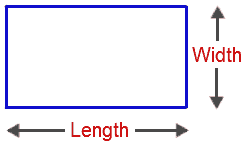One question I'm frequently asked is how many worms do I need to start a worm bin? When starting a new worm bin many of us are doing it on a budget. We usually have the bin first and want to start with enough worms but we're also aware of our spending if we are buying our starter worms. Today I'm going to help you figure out how many worms to buy based on the size of bin you're starting with.
1/2 pound of worms (don't buy by the count) for every square foot of bin surface area is enough to get a fairly good start at worm farming and provides enough space to allow the worms to breed into the bin. Much lower density and the worms will compost too slowly and higher density they'll become overcrowded fairly quickly and you'll spend more than necessary.
Calculating Surface Area
So you might remember the old length x width calculation from school.
If we measure the bin in inches, we need to convert square inches to square feet. to do this just take the number of square inches and divide by 144.
Let's practice by saying the bin above is inches by 14 inches:
24 x 14 = 336 square inches336 / 144 = 2.33 square feet.
So to get a good start the minimum we should start with is 1 pound of worms, but 2 will work if it's in our budget.
Basic math calculations like this is about as complicated as you need to get to operate even a large scale worm farm. to increase worm populations, from here you can keep splitting bins whenever they get crowded, or you can learn to do it the way commercial worm farmers do.
Calculating Worms Needed Based On Available Waste.
Over feeding worms is a frequent problem new worm farmers run into. This is exacerbated by worm growers that sell by count instead of weight; ultimately shipping short, hoping you won't count.
If you prefer to calculate how many worms (red wigglers) you'll need to handle all your available waste there are a few more variables and the calculation is a bit less accurate. You'll often see claims that worms can eat their own weight each day. This could hold true for certain water heavy and soft foods (watermelon and pumpkin for example) in ideal conditions. However my own measurements with random food waste are closer to eating their own weight in 5 to 7 days in "good conditions"
What you'll have to do is, collect all your food waste for at least a couple of weeks and weigh it. take an average weekly weight of food waste and buy that many worms (or round down).
For example your household produces 6.7 pounds of waste each week then start with 6 pounds of worms to be able to keep up to your household food waste.
Posted from my blog with SteemPress : https://thebluewormbin.com/how-to-calculate-how-many-worms-to-start-a-new-worm-bin-with/
